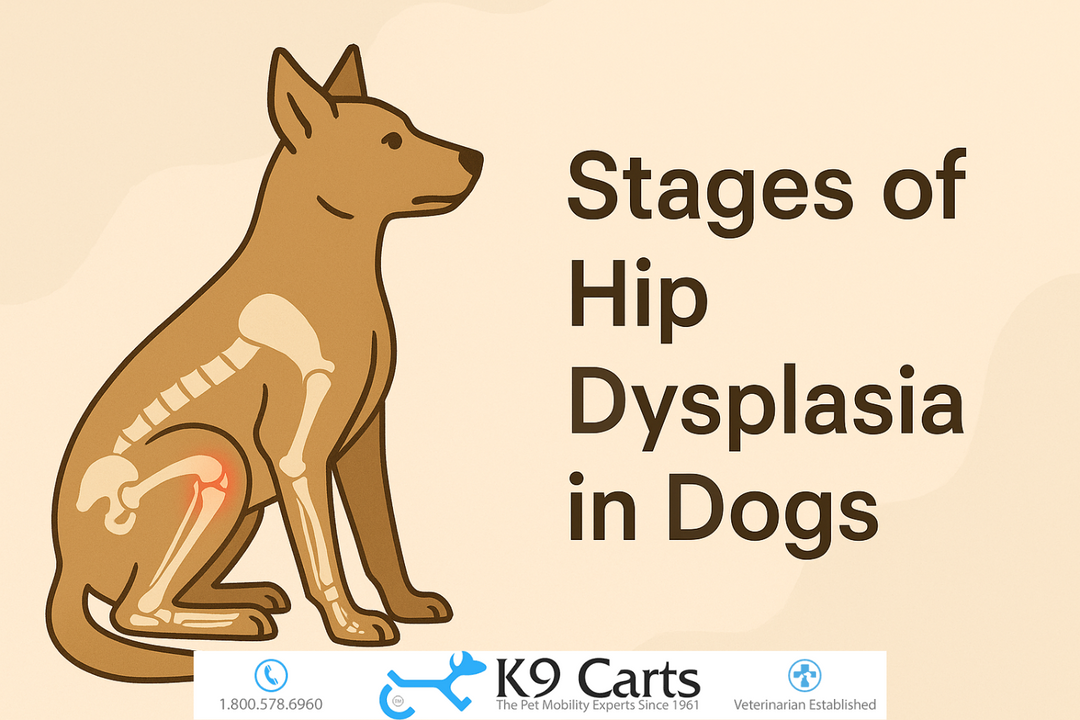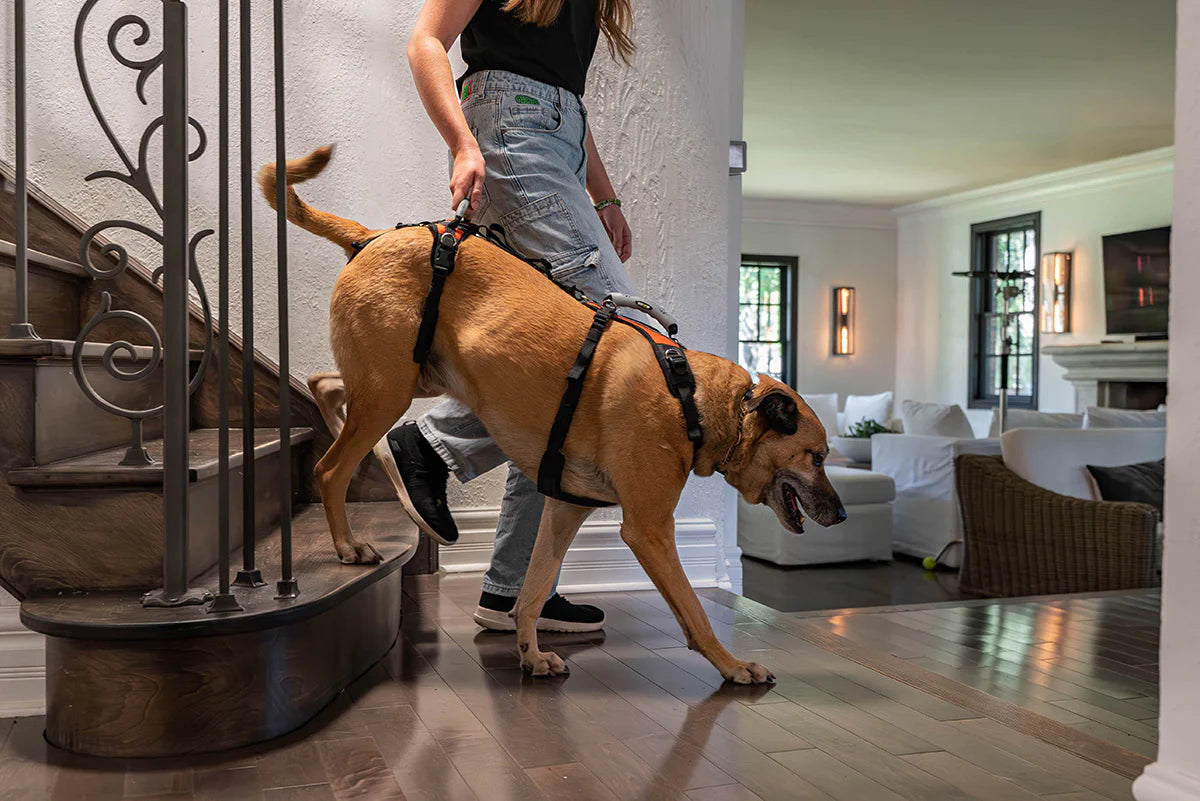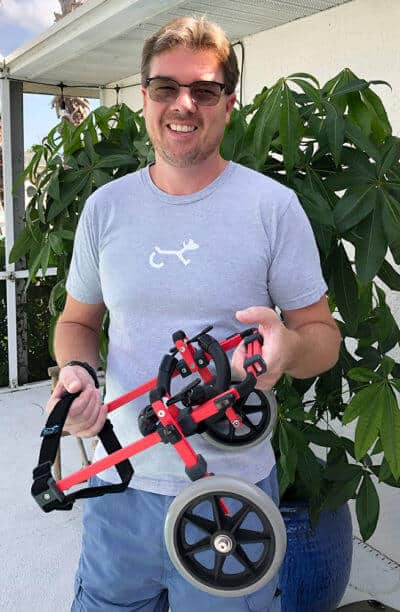Stages of Hip Dysplasia in Dogs: Early, Moderate & Severe Stages Explained

Hip dysplasia is one of the most common joint problems in dogs. Many dog owners know the term but may not fully understand what it means for their pet’s daily life. In this guide, we explain what hip dysplasia is, how it shows up at each stage, and how you can help your dog live more comfortably, even if the condition gets worse over time.
What is hip dysplasia in dogs?
Hip dysplasia happens when a dog’s hip joint does not fit together as it should. In a healthy hip, the ball and socket move smoothly. In a dog with hip dysplasia, the ball and socket do not line up well, which causes the joint to rub and grind. This leads to pain, swelling and loss of movement over time.
Large dog breeds are more likely to have hip dysplasia, but any dog can get it. Genetics, weight, diet and how fast a puppy grows can all play a role.
How can you spot hip dysplasia early?
Spotting hip dysplasia early can make a big difference in how you manage it. In the early stage, you might notice small signs that are easy to miss.
Early stage signs
Dogs in the early stage may seem stiff when they get up from lying down. Some dogs might hop instead of running smoothly. You may see them limping a bit after exercise or not wanting to play as much as before. Puppies might bunny-hop with their back legs together instead of moving them one at a time.
Many owners think their dog is just tired or sore from playing, so these signs often go unnoticed at first.
How vets diagnose early hip dysplasia
If you see any of these signs, your vet can check for hip dysplasia with a physical exam and X-rays. Early diagnosis helps you and your vet plan the right care.
What happens when hip dysplasia becomes moderate?
When hip dysplasia moves to a moderate stage, the damage in the hip joint gets worse. The joint wears down more, causing more pain and swelling.
Moderate stage signs
Dogs in the moderate stage may have more trouble standing up. They might limp often, lose muscle in their back legs or shift more weight to their front legs to avoid pain. Some dogs may stop jumping on furniture or into cars.
Your dog may also feel pain when touched near the hips. You might notice clicking or grinding sounds from the joint.
Managing moderate hip dysplasia
At this stage, your vet may suggest medicine to help with pain and swelling. Weight control is also very important. Keeping your dog at a healthy weight lowers stress on the hips.
Physical therapy can help keep muscles strong. Swimming is a good low-impact exercise for dogs with moderate hip dysplasia.
How severe hip dysplasia affects dogs
When hip dysplasia becomes severe, the hip joint is very damaged. Dogs in this stage often feel pain all the time.
Severe stage signs
Dogs in the severe stage may have trouble walking at all. They may fall more often, drag their back legs or stop using one back leg completely. Getting up and lying down becomes very hard.
Some dogs may not want to eat or may seem depressed because of constant pain.
Helping dogs with severe hip dysplasia
At this stage, your vet may talk with you about stronger pain relief, surgery or other options. Total hip replacement is one possible surgery for dogs who are healthy enough for it.
Many dogs with severe hip dysplasia lose strength in their back legs. This is when a dog wheelchair can be life-changing. A wheelchair helps take weight off the hips and supports the back legs. This gives dogs freedom to move again, even if they can no longer use their back legs well on their own.
How custom-built dog wheelchairs can help
Not every dog with hip dysplasia needs a wheelchair. But for many dogs in the moderate to severe stage, it can be the best way to stay mobile.
K9 Carts designs wheelchairs that match each dog’s size, shape and strength. The custom fit makes sure the wheelchair is comfortable and safe. It supports the hips and back legs, helping the dog stand and walk without extra pain.
Many dog owners see their pets become happier and more active again when they can move around freely. A wheelchair can also help keep other parts of the body strong because dogs can still get the exercise they need.
Can hip dysplasia be prevented?
Hip dysplasia cannot always be prevented, but there are steps you can take to lower the risk.
Feed puppies a balanced diet made for their breed size. Overfeeding can cause fast growth, which puts more stress on the hips. Make sure your dog gets regular, low-impact exercise and stays at a healthy weight.
Ask your vet about joint supplements like glucosamine or omega-3 fatty acids. These can help keep the joints healthy.
Responsible breeders screen their breeding dogs for hip problems to lower the risk of passing hip dysplasia to puppies.
When should you talk to your vet?
If you see any signs of hip pain or stiffness in your dog, it is a good idea to talk to your vet. Early treatment can slow down damage and make your dog’s life easier.
If your dog has trouble standing or walking, ask your vet if a wheelchair could help. Many dogs adjust quickly to using a wheelchair and enjoy the freedom to move without pain.
Keeping your dog comfortable for years to come
Hip dysplasia can change your dog’s life, but it does not have to stop them from being active and happy. With good care, the right treatment and the right tools, your dog can still enjoy walks, playtime and daily life with you.
K9 Carts has helped thousands of dogs stay on their feet with custom-built wheelchairs made just for them. If you ever want to learn more about how a wheelchair can help your dog, we are here to help you find the best solution for your best friend.
Your dog depends on you for comfort, care and love. By staying informed and working with your vet, you can help your dog live a full, happy life at every stage of hip dysplasia.








